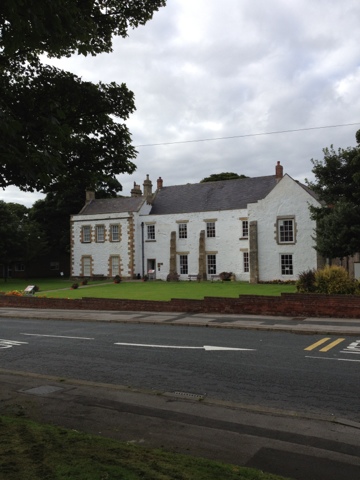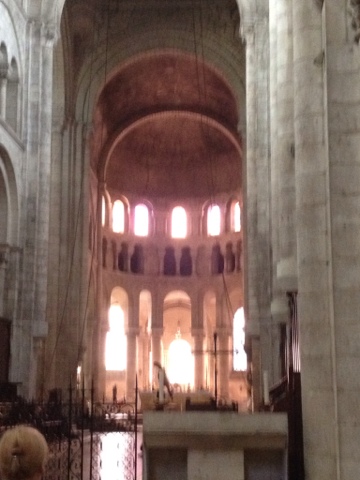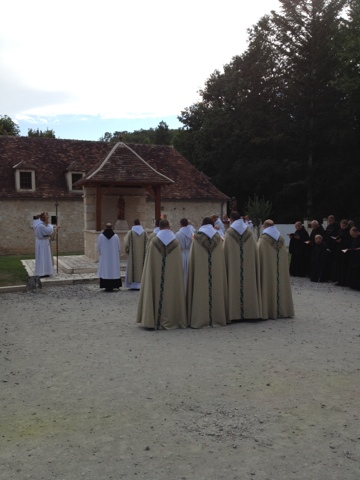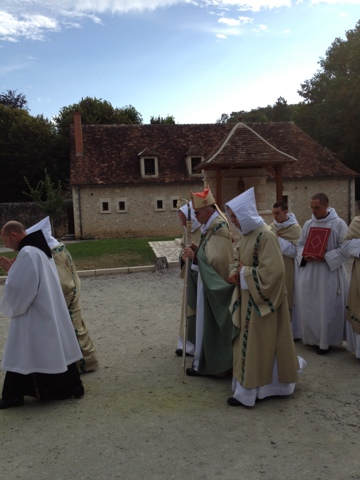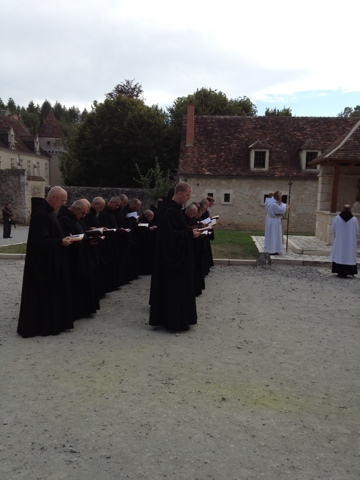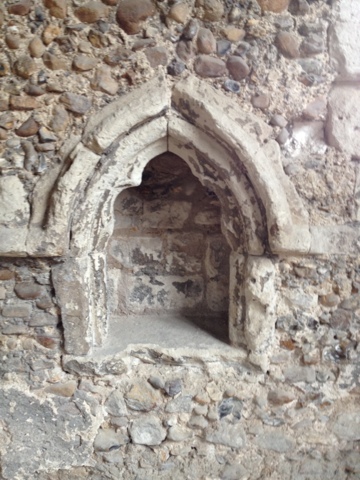St Dunstan’s, Mayfield was founded in 960 AD by St Dunstan, who was then Archbishop of Canterbury. Believed to be originally a wooden church it was replaced by a stone structure, in the twelfth century, by the Normans.
In 1389 this church was virtually destroyed by fire. Only the tower, the lancet window in the west wall and the base of the north aisle survive to this day. The local congregation probably used the private chapel at the Archbishop’s Palace nearby until the church was rebuilt between 1410 and 1420.
Friday 31 August 2012
St Mary's, Easington in County Durham
St Mary's Church dates from the early 13th century and stands proud over the medieval village of Easington and the later former coal mining community of Easington Colliery on the Durham coast.
Opposite the Church is one of the oldest extant domestic buildings in England. Seaton Holme was used for various purposes over the centuries including, originally as a residence for the Bishops and then Archdeacons of Durham. Pope Adrian IV as Nicholas Brakespere is rumoured to have lived here whilst possibly holding the title of Archdeacon of Durham.
Opposite the Church is one of the oldest extant domestic buildings in England. Seaton Holme was used for various purposes over the centuries including, originally as a residence for the Bishops and then Archdeacons of Durham. Pope Adrian IV as Nicholas Brakespere is rumoured to have lived here whilst possibly holding the title of Archdeacon of Durham.
Wednesday 22 August 2012
Surprised by joy
I have lived a mile from St Mary and All Saints Church in Willingham, North of Cambridge since 1997 but I had never been inside until this afternoon, when I called in after visiting the local grocers. The church has been there since 1230 and if ever anyone doubted that England was once a Catholic country they should visit this church or others like it that give vibrant witness to the public piety of the people of our land prior to the protestant reformation.
Here one is struck by so much of beauty but perhaps especially the wall paintings, most of which are from the 14th & 15th centuries. The first painting one is invited to look at by the guidebook however dates from around 1244 and is believed to be the oldest known wall painting of St Etheldreda, foundress of Ely Abbey. St Bede wrote of Etheldreda sustaining a wound to her neck where a tumour was removed during her last illness. This can clearly be seen in the painting although my picture doesn't do it justice. Her picture is on the opposite side of a vault window to that of her sister, St Sexburga
14th Century wall paintings on the north wall of the nave depict St George and the Dragon and also, very clearly, St Christopher as can been seen here.
One particularly exciting part of the church is the stone 'sacristy' built on the north side of the chancel in the 13th Century. This was probably originally as Anchorage as its floor are is 140 sq ft as prescribed in the Bavarian anchorite rule. It also has a squint doorway for the occupant to see the altar during mass without being seen himself and a small window to the outside world for receiving food and drink etc.
Here one is struck by so much of beauty but perhaps especially the wall paintings, most of which are from the 14th & 15th centuries. The first painting one is invited to look at by the guidebook however dates from around 1244 and is believed to be the oldest known wall painting of St Etheldreda, foundress of Ely Abbey. St Bede wrote of Etheldreda sustaining a wound to her neck where a tumour was removed during her last illness. This can clearly be seen in the painting although my picture doesn't do it justice. Her picture is on the opposite side of a vault window to that of her sister, St Sexburga
 |
| St Etheldreda |
 |
| St Sexburga |
14th Century wall paintings on the north wall of the nave depict St George and the Dragon and also, very clearly, St Christopher as can been seen here.
 |
| St Christopher |
There are also three carved oak screens. One in the traditional place was the rood screen and includes some fine carvings. A second screen enclosing what was once a chapel on the north side and the third surrounds the chapel on the south, near to the main door.
| Detail of carving of a fish on the Rood Screen doors |
| Screen enclosing the organ with remains of paintings on the base. From 1320 and the oldest in Cambridgeshire |
 |
| Hammer-beam roof with (modern) carved angels |
What a privilege to say my Pater, Ave and Gloria Patri there today as many thousands of loyal Catholics had also done in earlier centuries.
Tuesday 21 August 2012
Wednesday 15 August 2012
Assumption at Fontgombault
Three members of SSIM, accompanied by a priest from the Southwark Archdiocese, celebrated the Assumption at the Benedictine Abbey of Fontgombault in the centre of France. (photos to follow)
The Abbey is a part of the Solesmes Benedictine Congregation and celebrates the traditional forms of the office and Mass. The Pope, when Cardinal Ratzinger, stayed and lectured there as part of a liturgical conference a number of years ago and it is an oasis of stillness and prayer, soaked in the monastic spirit of St Benedict.
Fr Abbot celebrated Pontifical First Vespers on the 14th as well as Pontifical High Mass and Second Vespers and Benediction on the 15th. Vespers was followed by a solemn procession in honour of Our Lady in which at least 56 monks participated with lots of young people and families as well as seminarians and other guests of the Abbey.
Our Lady of the Assumption is patroness of France and the solemn procession is held in consequence of the act of consecration of France to Our Lady of the Assumption by King Louis XIII made in 1638. This he did to thank Her (in advance) for the birth of his son, the future Lois XIV.
Prayers have been offered for all SSIM members at the feet of Our Lady's image in the Abbey Church.
The Abbey is a part of the Solesmes Benedictine Congregation and celebrates the traditional forms of the office and Mass. The Pope, when Cardinal Ratzinger, stayed and lectured there as part of a liturgical conference a number of years ago and it is an oasis of stillness and prayer, soaked in the monastic spirit of St Benedict.
Fr Abbot celebrated Pontifical First Vespers on the 14th as well as Pontifical High Mass and Second Vespers and Benediction on the 15th. Vespers was followed by a solemn procession in honour of Our Lady in which at least 56 monks participated with lots of young people and families as well as seminarians and other guests of the Abbey.
Our Lady of the Assumption is patroness of France and the solemn procession is held in consequence of the act of consecration of France to Our Lady of the Assumption by King Louis XIII made in 1638. This he did to thank Her (in advance) for the birth of his son, the future Lois XIV.
Prayers have been offered for all SSIM members at the feet of Our Lady's image in the Abbey Church.
Thursday 9 August 2012
Watford
The C of E parish church of St Mary the Virgin in Watford was built in 1230 on the same site as an earlier Saxon church. It was extensively restored in 1871 and is now very firmly rooted in Evangelical Anglicanism. None the less one of our faithful members recently visited to execute the SSIM duties.
Of interest nearby is the gorgeous Church of the Holy Rood a parish church in the Archdiocese of Westminster. The Grade 1 listed gothic revival church was designed by John Francis Bentley, the architect of Westminster Cathedral.
Holy Rood is usually only open at Mass times, so check out their website if you want to visit:
Monday 6 August 2012
Beaconsfield
Whilst the present Anglican Church of St Mary and All Saints was built in 1869, there has been a Church on the same site since the 13th Century. A member visited recently to offer his SSIM prayers and pray for the unity of the Church.
St Mary's has an interesting link to recent strivings for Christian unity as Fr John Hunwicke, recently ordained Catholic priest, was once Vicar there.
Interestingly, GK Chesterton, himself a convert, who lived in the town and is buried there, habitually heard Mass at the Catholic Church of St Teresa. The original headstone from his grave, carved by Eric Gill, is preserved on the outside wall of the Church.
St Mary's has an interesting link to recent strivings for Christian unity as Fr John Hunwicke, recently ordained Catholic priest, was once Vicar there.
Interestingly, GK Chesterton, himself a convert, who lived in the town and is buried there, habitually heard Mass at the Catholic Church of St Teresa. The original headstone from his grave, carved by Eric Gill, is preserved on the outside wall of the Church.
Friday 3 August 2012
Farnborough Abbey
Tomorrow one of our members begins his noviciate as an Oblate of the Benedictine St Michael's Abbey, Farnborough in Hampshire, UK.
Farnborough is a remarkable community of monks of the Subiaco Congregation of the Order of St Benedict.
In their own words:
" Our monastery has a rich and multi-faceted history.
"In 1880, the Empress Eugénie [if France] bought a house in Farnborough. Crushed by the loss of her husband Napoleon III in 1873 and the death in 1879 of her 23 year old son in the Zulu War, she built St Michael’s Abbey as a monastery and the Imperial Mausoleum.
"Dom Cabrol, the prior of the French Abbey of Saint Pierre de Solesmes, had dreamed of a monastic foundation dedicated to liturgical studies, but no suitable property or funding had been found, though the vicissitudes of the anti-clerical France of the 1890s made the thought of a house abroad increasingly attractive. The Empress Eugénie invited these French Benedictines here in 1895 and thus the daily round of work, prayer and study began.
"Monsignor Ronald Knox, who was received into the Catholic Church here, described the Abbey as ‘a little corner of England which is forever France, irreclaimably French.’ In 1947 a little band of monks came from Prinknash Abbey, near Gloucester, to anglicise the house and ensure the continuity of the monastic life here. The last French monk, Dom Zerr, died in 1956.
"The community today draws on the richness of more than a hundred years of monastic prayer and witness in this place and more than 1500 years of Benedictine tradition."
Please pray for Father Abbot and the Community at Farnborough and visit their website: http://www.farnboroughabbey.org
Farnborough is a remarkable community of monks of the Subiaco Congregation of the Order of St Benedict.
In their own words:
" Our monastery has a rich and multi-faceted history.
"In 1880, the Empress Eugénie [if France] bought a house in Farnborough. Crushed by the loss of her husband Napoleon III in 1873 and the death in 1879 of her 23 year old son in the Zulu War, she built St Michael’s Abbey as a monastery and the Imperial Mausoleum.
"Dom Cabrol, the prior of the French Abbey of Saint Pierre de Solesmes, had dreamed of a monastic foundation dedicated to liturgical studies, but no suitable property or funding had been found, though the vicissitudes of the anti-clerical France of the 1890s made the thought of a house abroad increasingly attractive. The Empress Eugénie invited these French Benedictines here in 1895 and thus the daily round of work, prayer and study began.
"Monsignor Ronald Knox, who was received into the Catholic Church here, described the Abbey as ‘a little corner of England which is forever France, irreclaimably French.’ In 1947 a little band of monks came from Prinknash Abbey, near Gloucester, to anglicise the house and ensure the continuity of the monastic life here. The last French monk, Dom Zerr, died in 1956.
"The community today draws on the richness of more than a hundred years of monastic prayer and witness in this place and more than 1500 years of Benedictine tradition."
Please pray for Father Abbot and the Community at Farnborough and visit their website: http://www.farnboroughabbey.org
Thursday 2 August 2012
Oxford & Reading
One of our newer members has made contact to say he has visited St Mary Magdalen, Oxford and Grey Friars Reading today.
Grey Friars is the oldest Franciscan church still in use in the UK. The Franciscans first arrived in Reading in 1233 and occupied the current site from 1311 up to the dissolution of the Friary in 1538. It is now firmly within the evangelical Anglican tradition.
By contrast St Mary Magdalen's Oxford is a well known Anglo-catholic church. (see pic). There was a wooden church of St Mary Magdalen on the site a thousand years ago. St Hugh of Lincoln rebuilt the church in 1194.
More recently (1841-42) Gilbert Scott worked on the church to complement his nearby Martyrs' memorial, dedicated to the Protestant martyrs Cranmer, Ridley and Latimer. Let us pray for the repose of their souls as we invoke the intercession of St Mary Magdalen, St Francis of Assisi and all the Franciscan saints and beati.
Grey Friars is the oldest Franciscan church still in use in the UK. The Franciscans first arrived in Reading in 1233 and occupied the current site from 1311 up to the dissolution of the Friary in 1538. It is now firmly within the evangelical Anglican tradition.
By contrast St Mary Magdalen's Oxford is a well known Anglo-catholic church. (see pic). There was a wooden church of St Mary Magdalen on the site a thousand years ago. St Hugh of Lincoln rebuilt the church in 1194.
More recently (1841-42) Gilbert Scott worked on the church to complement his nearby Martyrs' memorial, dedicated to the Protestant martyrs Cranmer, Ridley and Latimer. Let us pray for the repose of their souls as we invoke the intercession of St Mary Magdalen, St Francis of Assisi and all the Franciscan saints and beati.
Support for SSIM from Mgr Keith Newton
In a letter, sent last year to our Chaplain of Associates, Fr Bob Penhallurick, the Ordinary of the Personal Ordinariate of Our Lady of Walsingham, said the following:
"I will certainly recommend that our priests find out more about the Society and hope that some of them with their lay people may join. .....the Society is particularly appropriate for members of the Ordinariate...."
We are very grateful for this endorsement and assure the Ordinary of our prayers as he seeks to implement the Holy Father's vision for the conversion of our separated brethren.
"I will certainly recommend that our priests find out more about the Society and hope that some of them with their lay people may join. .....the Society is particularly appropriate for members of the Ordinariate...."
We are very grateful for this endorsement and assure the Ordinary of our prayers as he seeks to implement the Holy Father's vision for the conversion of our separated brethren.
Wednesday 1 August 2012
Duxford Chapel
Just off the M11 close to the imperial war museum is the 13c Chapel of St John, Baptist. It is located on one of the crossings over the River Cam of the Icknield Way.
Originally part of a hospital for travellers using the Icknield Way, it was founded by Sir William de Colville.
From its foundation, until 1308, when the property of the Knights Templar in England were confiscated, the Chapel is believed to have belonged to Duxford Preceptory of the Templars. The Chapel fell into disrepair and was given, in 1324, by the Crown, to the Knights Hospitaler. They rebuilt the chapel in 1327 as a chantry for Sir William. The right of appointment of a chantry priest lay with the Bishops of Ely.
The Chantry came to an end in 1557 with the Act of Dissolution of Colleges and Chantries of King Edward VI
Some notable features include a single seat 'Sedilia', a scallop shaped piscina and in the north wall, an Easter Sepulchre - very much a part of English Catholic patrimony.
Originally part of a hospital for travellers using the Icknield Way, it was founded by Sir William de Colville.
From its foundation, until 1308, when the property of the Knights Templar in England were confiscated, the Chapel is believed to have belonged to Duxford Preceptory of the Templars. The Chapel fell into disrepair and was given, in 1324, by the Crown, to the Knights Hospitaler. They rebuilt the chapel in 1327 as a chantry for Sir William. The right of appointment of a chantry priest lay with the Bishops of Ely.
The Chantry came to an end in 1557 with the Act of Dissolution of Colleges and Chantries of King Edward VI
Some notable features include a single seat 'Sedilia', a scallop shaped piscina and in the north wall, an Easter Sepulchre - very much a part of English Catholic patrimony.
Subscribe to:
Posts (Atom)

